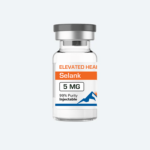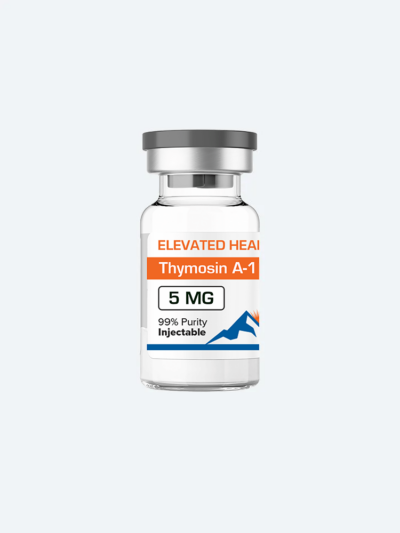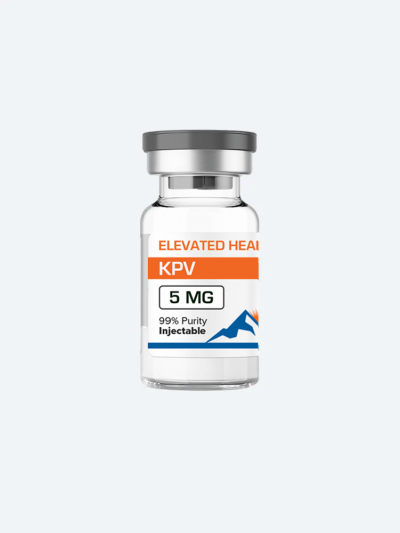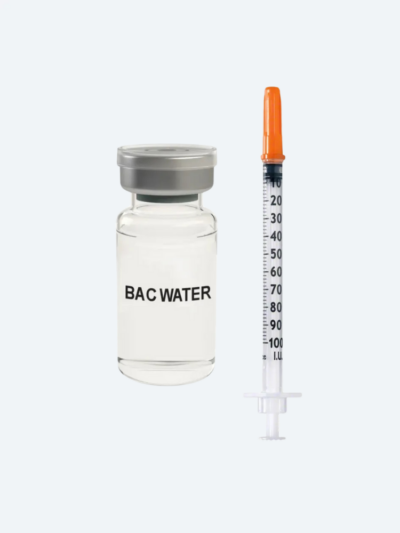No products in the cart.
Back

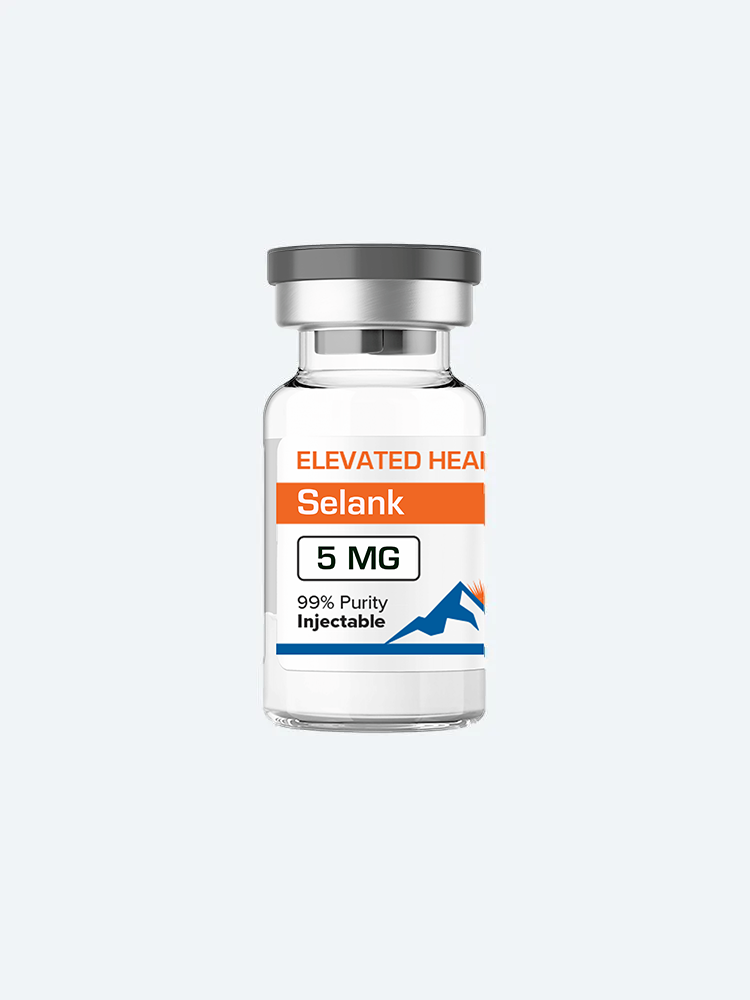
In stock
Selank
Mood Boosting, Peptides$55.00
SKU: 29045-SB-9-51
5 mg Nasal Spray or Injectable
Ingredients – 5 mg Selank (Tuftsin) Peptide
Indications – anxiolytic, antidepressant, and immunomodulatory, enhance cognitive function
Dosage – 250mcg 3x per day via nasal spray, or 200mcg 1x per day via injection
Selank, which was developed in Russia, is a short peptide with nootropic and anxiolytic properties. It is a synthetic analogue of naturally occurring Tuftsin, an immunomodulatory peptide that modulates IL-6, T helper cells, monoamine neurotransmitters, and brain-derived neurotropic factor (BDNF). In fact, Selank and Tuftsin are essentially the same except that Selank has an additional four amino acids in its chain that help to improve metabolic stability and half-life.
Selank is a versatile peptide known for its ability to relieve anxiety and depression by increasing serotonin levels in the brain. Originally prescribed for mood disorders, Selank has since shown effectiveness in treating a variety of conditions, including immune modulation, PTSD, ADHD, and metabolic syndromes. Whether you’re managing anxiety, recovering from trauma, or seeking a nootropic boost, Selank provides a safe and effective solution for improving mental and emotional well-being.
Selank is unique in that it combines both anxiolytic and nootropic properties, making it a powerful tool for improving mood, reducing stress, and enhancing cognitive function. As an anxiolytic, Selank helps reduce symptoms of anxiety and depression by regulating neurotransmitter levels in the brain, including serotonin, dopamine, and GABA. These neurotransmitters play a crucial role in mood regulation, anxiety, and cognitive processes, and by balancing their levels, Selank helps promote a sense of calm and well-being. Additionally, Selank has nootropic effects, meaning it enhances cognitive function by improving memory formation and learning processes.
- Description
Overview
Selank is a synthetic analog of tuftsin, an endogenous tetrapeptide that plays a role in regulating the immune system. Some researchers informally classify Selank as a nootropic—a compound that can enhance cognitive function, improve memory, and increase mental clarity.
Selank was developed in the early 1990s at the Russian Academy of Sciences and has primarily been studied for its anxiolytic (anti-anxiety) effects. It is believed to work by modulating neurotransmitters including serotonin, dopamine, and GABA. With these mechanisms, Selank can help reduce anxiety and promote a sense of calmness without causing sedation or impairing cognitive function.
In addition to its anxiolytic properties, Selank has also been studied for its potential benefits in reducing pain and inflammation, while enhancing the immune system. It has shown promise in preclinical and clinical studies for the treatment of anxiety disorders, depression, and cognitive impairments.
Selank has profound effects on cognition and is believed to act through the GABAergic system. In rat studies, Selank administration has been shown to alter the gene expression of GABA receptors, causing them to have a greater affinity for GABA. This enhances GABA’s ability to inhibit excitability in the CNS similar to the administration of benzodiazepines—although, crucially, without their associated side effects and addictive potential.
Selank also appears to provide protection against alcohol-induced memory loss that occurs when brain-derived neurotrophic factor (BDNF) increases in the hippocampus and frontal cortex. In an experiment where rats were given only alcohol to drink for 30 weeks, rats who were also given Selank performed better on object recognition tasks, did not exhibit the same memory and attention deficits, and did not have increased BDNF compared to the untreated rats.
Memory and Learning
There has long been an association between anxiety and learning/memory. The correlation is a negative one, with increased anxiety leading to decreased ability to recall memories or store new information. Traditional anxiety treatments can reduce this effect, as can Selank, but Selank appears to do more than simply reduce the impact of anxietv on cognitive function. There is good reason to believe that Selank actually boosts cognition directly.
Research in rats trains with food rewards and iniected with either saline or Selank has shown that Selank boosts memory trace stability and thus enhances the memory storage process. It is important to note that this benefit was seen regardless of the anxiety levels of the rats, indicating that the peptide has effects beyond its ability to simply reduce stress-related impairment of memorv.
It appears that Selank may alter memory by affecting the expression of a number of genes in the hippocampus. Research in rats shows changes in mRNA levels of 36 different genes after intranasal administration of Selank. Most of the genes encode proteins associated with the plasma membrane and may therefore modulate ion-dependent processes in learning and memory[1]. Though much research needs to be done to understand the mechanism by which Selank works to improve memory and learning, this research offers a tantalizing early clue to suggest that it alters the way neurons function in such a way that both forming and accessing memories is easier.
Furthermore, research even suggests that Selank can help to rescue memory and learning following damage to the brain. Rats treated with a neurotoxin and then Selank showed restored cognitive processes in at least one study. This effect appears to be related to an artificial inhibition of the catecholamine system in the brain by Selank. There is some hope that Selank will help to shed light on how cognitive function can be restored or at least improved following traumatic brain injury, particularly the kinds of injury that occurring during the birth process.
Anxiety Effects Based on Genes Related to GABA Neurotransmitter
Numerous clinical studies have shown that Selank has strong antianxiety and neuroprotective effects in the treatment of anxiety. The clinical effects of Selank are similar to those of the classical anti-anxiety medications such as benzodiazepine, which are allosteric modulators of GABAA receptors and increase the inhibitory action of GABA. Like benzodiazepines, low doses of Selank have a sedating effect. Unlike benzodiazepines, Selank does not appear to be habit-forming and does not lead to symptoms of withdrawal or amnesia.
Research in rats shows that of the 84 genes known to be connected to GABA signaling in some way, seven are heavily modulated by Selank and 45 show some change in expression when the peptide is administered. Overall, 52 genes related to GABA signaling are affected by Selank to some dearee. These results indicate that Selank can directly influence the expression of genes in nerve cells and that it likely produces effects by changing the affinity of the GABA receptor for GABA. This alteration of receptor affinity likely explains why Selank is synergistic with benzodiazepines and other GABA receptor agonists.
Pain Management
Research in rats shows that of the 84 genes known to be connected to GABA signaling in some way, seven are heavily modulated by Selank and 45 show some change in expression when the peptide is administered. Overall, 52 genes related to GABA signaling are affected by Selank to some dearee. These results indicate that Selank can directly influence the expression of genes in nerve cells and that it likely produces effects by changing the affinity of the GABA receptor for GABA. This alteration of receptor affinity likely explains why Selank is synergistic with benzodiazepines and other GABA receptor agonists.
References
- Mosa, R. M., Zhang, Z., Shao, R., Deng, C., Chen, J., & Chen, C. (2015). Implications of Ghrelin and Hexarelin in Diabetes and Diabetes-Associated Heart Diseases. Endocrine, 49(2), 307–323. https://doi.org/10.1007/s12020-015-0531-z.
- Bowers, C.,Momany, F., Reynolds, G.,Hong, A. (1984). On the in Vitro and in Vivo Activity of a New Synthetic Hexapeptide that Acts on the Pituitary to Specifically Release Growth Hormone. Endocrinology, 11(5), 1537–1545. https://doi.org/10.1210/endo-114-5-1537
- Meanti, R., Licata, M., Rizzi, L., Bresciani, E., Molteni, L., Coco, S., Locatelli, V., Omeljaniuk, R. J., & Torsello, A. (2023). Protective Effects of Hexarelin and JMV2894 in a Human Neuroblastoma Cell Line Expressing the SOD1-G93A Mutated Protein. International Journal of Molecular Sciences, 24(2), 993. https://doi.org/10.3390/ijms24020993
- Mao, Y., Tokudome, T., & Kishimoto, I. (2014). The Cardiovascular Action of Hexarelin. Journal of Geriatric Cardiology, 11(3), 253–258. https://doi.org/10.11909/j.issn.1671-5411.2014.03.007
- Rahim, A., O’Neill, P. A., & Shalet, S. M. (1998). Growth Hormone Status During Long-Term Hexarelin Therapy. The Journal of Clinical Endocrinology And Metabolism, 83(5), 1644–1649. https://doi.org/10.1210/jcem.83.5.4812.
- Bartke A. (2019). Growth Hormone and Aging: Updated Review. The World Journal of Men’s Health, 37(1), 19–30. https://doi.org/10.5534/wjmh.180018
- Doessing, S., Heinemeier, K. M., Holm, L., Mackey, A. L., Schjerling, P., Rennie, M., Smith, K., Reitelseder, S., Kappelgaard, A. M., Rasmussen, M. H., Flyvbjerg, A., & Kjaer, M. (2010). Growth Hormone Stimulates the Collagen Synthesis in Human Tendon and Skeletal Muscle Without Affecting Myofibrillar Protein Synthesis. The Journal of Physiology, 588(2), 341–351. https://doi.org/10.1113/jphysiol.2009.179325.
- Kopchick, J. J., Berryman, D. E., Puri, V., Lee, K. Y., & Jorgensen, J. O. L. (2020). The Effects of Growth Hormone on Adipose Tissue: Old Observations, New Mechanisms. Nature Reviews. Endocrinology, 16(3), 135–146. https://doi.org/10.1038/s41574-019-0280-9
- Kraemer, W. J., Ratamess, N. A., & Nindl, B. C. (2017). Recovery Responses of Testosterone, Growth Hormone, and IGF-1 After Resistance Exercise. Journal of Applied Physiology, 122(3), 549–558. https://doi.org/10.1152/japplphysiol.00599.2016.
- Vyazovskiy V. V. (2015). Sleep, Recovery, And Metaregulation: Explaining the Benefits of Sleep. Nature And Science of Sleep, 7, 171–184. https://doi.org/10.2147/NSS.S54036
- Van Cauter, E., & Copinschi, G. (2000). Interrelationships Between Growth Hormone and Sleep. Growth Hormone & IGF Research: Official Journal of the Growth Hormone Research Society and the International IGF Research Society, 10 Suppl B, S57–S62. https://doi.org/10.1016/s1096-6374(00)80011-8
- Clamp, L. D., Hume, D. J., Lambert, E. V., & Kroff, J. (2017). Enhanced Insulin Sensitivity in Successful, Long-Term Weight Loss Maintainers Compared With Matched Controls With No Weight Loss History. Nutrition & Diabetes, 7(6), e282. https://doi.org/10.1038/nutd.2017.31
- Mosa, R., Huang, L., Wu, Y., Fung, C., Mallawakankanamalage, O., LeRoith, D., & Chen, C. (2017). Hexarelin, a Growth Hormone Secretagogue, Improves Lipid Metabolic Aberrations in Nonobese Insulin-Resistant Male MKR Mice. Endocrinology, 158(10), 3174–3187. https://doi.org/10.1210/en.2017-00168.
- Mao, Y., Tokudome, T., Kishimoto, I., Otani, K., Miyazato, M., & Kangawa, K. (2014). One Dose of Oral Hexarelin Protects Chronic Cardiac Function After Myocardial Infarction. Peptides, 56, 156–162. https://doi.org/10.1016/j.peptides.2014.04.004.
- Pang, J., Xu, Q., Xu, X., Yin, H., Xu, R., Guo, S., Hao, W., Wang, L., Chen, C., & Cao, J. M. (2010). Hexarelin Suppresses High Lipid Diet and Vitamin D3-Induced Atherosclerosis in the Rat. Peptides, 31(4), 630–638. https://doi.org/10.1016/j.peptides.2009.11.007
- Sirago, G., Conte, E., Fracasso, F., Cormio, A., Fehrentz, J. A., Martinez, J., Musicco, C., Camerino, G. M., Fonzino, A., Rizzi, L., Torsello, A., Lezza, A. M. S., Liantonio, A., Cantatore, P., & Pesce, V. (2017). Growth Hormone Secretagogues Hexarelin and JMV2894 Protect Skeletal Muscle from Mitochondrial Damages in a Rat Model of Cisplatin-Induced Cachexia. Scientific Reports, 7(1), 13017. https://doi.org/10.1038/s41598-017-13504-y
- Rodrigue-Way, A., Demers, A., Ong, H., & Tremblay, A. (2007). A Growth Hormone-Releasing Peptide Promotes Mitochondrial Biogenesis and A Fat Burning-Like Phenotype Through Scavenger Receptor CD36 in White Adipocytes. Endocrinology, 148(3), 1009–1018. https://doi.org/10.1210/en.2006-0975
- Massoud, A. F., Hindmarsh, P. C., & Brook, C. G. (1996). Hexarelin-Induced Growth Hormone, Cortisol, And Prolactin Release: A Dose-Response Study. The Journal of Clinical Endocrinology and Metabolism, 81(12), 4338–4341. https://doi.org/10.1210/jcem.81.12.8954038.
- Hintz R. L. (2004). Growth Hormone: Uses and Abuses. BMJ (Clinical research ed.), 328(7445), 907–908. https://doi.org/10.1136/bmj.328.7445.907
- U.S. Department of Health and Human Services. (2018). Cushing’s Syndrome – NIDDK. National Institute of Diabetes and Digestive and Kidney Diseases. https://www.niddk.nih.gov/health-information/endocrine-diseases/cushings-syndrome#symptoms
- Thapa, S., & Bhusal, K. (2022). Hyperprolactinemia. In StatPearls. StatPearls Publishing.
- Kumar, P., Kumar, N., Thakur, D. S., & Patidar, A. (2010). Male Hypogonadism: Symptoms and Treatment. Journal of Advanced Pharmaceutical Technology & Research, 1(3), 297–301. https://doi.org/10.4103/0110-5558.72420
- Rahim, A., & Shalet, S. M. (1998). Does Desensitization to Hexarelin Occur? Growth Hormone & IGF Research: Official Journal of The Growth Hormone Research Society and The International IGF Research Society, 8 Suppl B, 141–143.
- Rahim, A., O’Neill, P. A., & Shalet, S. M. (1998). Growth Hormone Status During Long-Term Hexarelin Therapy. The Journal of Clinical Endocrinology And Metabolism, 83(5), 1644–1649. https://doi.org/10.1210/jcem.83.5.4812.
- Sigalos, J. T., & Pastuszak, A. W. (2018). The Safety and Efficacy of Growth Hormone Secretagogues. Sexual Medicine Reviews, 6(1), 45–53. https://doi.org/10.1016/j.sxmr.2017.02.004
- Freeze-Drying: Producing Stable Peptides. (2023). Manufacturing Chemist. https://www.manufacturingchemist.com/news/article_page/Freeze-drying_producing_stable_peptides/206036.
- Sterile Water for Injection, USP – Food and Drug Administration. (2022). https://www.accessdata.fda.gov/drugsatfda_docs/label/2016/018632s051lbl.pdf.
- National Institutes of Health. (2014). Bacteriostatic Water. U.S. National Library of Medicine. https://dailymed.nlm.nih.gov/dailymed/fda/fdaDrugXsl.cfm?setid=ccadcf46-6a6f-436b-9bbc-17e2983a335f&type=display.
- Peptide Handling, Dissolution, and Storage. NIBSC. (2003). https://www.nibsc.org/science_and_research/virology/cjd_resource_centre/available_samples/peptide_library/peptide_storage.aspx.
- De Marinis, L., Mancini, A., Valle, D., Izzi, D., Bianchi, A., Gentilella, R., Giampietro, A., Desenzani, P., & Giustina, A. (2000). Role Of Food Intake In The Modulation Of Hexarelin-Induced Growth Hormone Release In Normal Human Subjects. Hormone And Metabolic Research, 32(4), 152–156. https://doi.org/10.1055/s-2007-978611.
- U.S. National Library of Medicine. (2021). Subcutaneous (SQ) Injections: Medlineplus Medical Encyclopedia. MedlinePlus. https://medlineplus.gov/ency/patientinstructions/000430.htm
- U.S. Department of Health and Human Services. (2023). Anabolic Steroids and Other Appearance and Performance Enhancing Drugs (APEDs). National Institutes of Health. https://nida.nih.gov/research-topics/anabolic-steroids#types
- A. Volkova et al., “Selank Administration Affects the Expression of Some Genes Involved in GABAergic Neurotransmission,” Front. Pharmacol., vol. 7, Feb. 2016. PubMed: https://www.ncbi.nlm.nih.gov/pubmed/26924987
- A. Kasian et al., “Peptide Selank Enhances the Effect of Diazepam in Reducing Anxiety in Unpredictable Chronic Mild Stress Conditions in Rats,” Behavioural Neurology, 2017. Available: https://www.hindawi.com/journals/bn/2017/5091027/
- A. A. Zozulya et al., “The inhibitory effect of Selank on enkephalin-degrading enzymes as a possible mechanism of its anxiolytic activity,” Bull. Exp. Biol. Med., vol. 131, no. 4, pp. 315–317, Apr. 2001. PubMed: https://www.ncbi.nlm.nih.gov/pubmed/11550013
- O. Y. Sokolov, V. K. Meshavkin, N. V. Kost, and A. A. Zozulya, “Effects of Selank on behavioral reactions and activities of plasma enkephalin-degrading enzymes in mice with different phenotypes of emotional and stress reactions,” Bull. Exp. Biol. Med. PubMed: https://www.ncbi.nlm.nih.gov/pubmed/12432865
- O. N. Uchakina et al., “[Immunomodulatory effects of selank in patients with anxiety-asthenic disorders],” Zh. Nevrol. Psikhiatr. Im. S. S. Korsakova, vol. 108, no. 5, pp. 71–75, 2008. PubMed: https://www.ncbi.nlm.nih.gov/pubmed/18577961
- A. A. Zozulia et al., “[Efficacy and possible mechanisms of action of a new peptide anxiolytic selank in the therapy of generalized anxiety disorders and neurasthenia],” Zh. Nevrol. Psikhiatr. Im. S. S. Korsakova, vol. 108, no. 4, pp. 38–48, 2008. PubMed: https://www.ncbi.nlm.nih.gov/pubmed/18454096
- T. Kolomin, M. Shadrina, L. Andreeva, P. Slominsky, S. Limborska, and N. Myasoedov, “Expression of inflammation-related genes in mouse spleen under tuftsin analog Selank,” Regul. Pept., vol. 170, no. 1–3, pp. 18–23, Oct. 2011. PubMed: https://www.ncbi.nlm.nih.gov/pubmed/21609736
- T. I. Agapova et al., “[Effect of semax on the temporary dynamics of brain-derived neurotrophic factor and nerve growth factor gene expression in the rat hippocampus and frontal cortex],” Mol. Genet. Mikrobiol. Virusol., no. 3, pp. 28–32, 2008. PubMed: https://www.ncbi.nlm.nih.gov/pubmed/18756821
- T. P. Semenova, I. I. Kozlovskii, N. M. Zakharova, and M. M. Kozlovskaia, “[Experimental optimization of learning and memory processes by selank],” Eksp. Klin. Farmakol., vol. 73, no. 8, pp. 2–5, Aug. 2010. PubMed: https://www.ncbi.nlm.nih.gov/pubmed/20919548
- T. A. Kolomin et al., “[c],” Zh. Vyssh. Nerv. Deiat. Im. I. P. Pavlova, vol. 63, no. 3, pp. 365–374, Jun. 2013.
- T. P. Semenova, M. M. Kozlovskaya, N. M. Zakharova, I. I. Kozlovskii, and A. V. Zuikov, “Effect of selank on cognitive processes after damage inflicted to the cerebral catecholamine system during early ontogeny,” Bull. Exp. Biol. Med., vol. 144. PubMed: https://www.ncbi.nlm.nih.gov/pubmed/18683497
- N. V. Kost et al., “[Semax and selank inhibit the enkephalin-degrading enzymes from human serum],” Bioorg. Khim., vol. 27, no. 3, pp. 180–183, Jun. 2001. Springer: https://link.springer.com/article/10.1023/A:1011373002885
REMINDER TO ALL CUSTOMERS:
Due to their sensitive nature and strict storage requirements: all sales are final on peptides & GH products. We cannot accept returns strictly because of product integrity and safety for all clients. Thank you for your understanding


